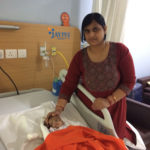- Diarrhoeal disease is the second leading cause of death in children under five years old. It is both preventable and treatable.
- Each year diarrhoea kills around 525 000 children under five.
- A significant proportion of diarrhoeal disease can be prevented through safe drinking-water and adequate sanitation and hygiene.
- Globally, there are nearly 1.7 billion cases of childhood diarrhoeal disease every year.
- Diarrhoea is a leading cause of malnutrition in children under five years old.
India
healthysoch
New Delhi, May 31, 2020 :
Diarrhoea is usually a symptom of an infection in the intestinal tract, which can be caused by a variety of bacterial, viral and parasitic organisms. Infection is spread through contaminated food or drinking-water, or from person-to-person as a result of poor hygiene.
Interventions to prevent diarrhoea, including safe drinking-water, use of improved sanitation and hand washing with soap can reduce disease risk. Diarrhoea should be treated with oral rehydration solution (ORS), a solution of clean water, sugar and salt. In addition, a 10-14 day supplemental treatment course of dispersible 20 mg zinc tablets shortens diarrheoa duration and improves outcomes.
There are three clinical types of diarrhoea:
- acute watery diarrhoea – lasts several hours or days, and includes cholera;
- acute bloody diarrhoea – also called dysentery; and
- persistent diarrhoea – lasts 14 days or longer.
Scope of diarrhoeal disease
Diarrhoeal disease is a leading cause of child mortality and morbidity in the world, and mostly results from contaminated food and water sources. Worldwide, 780 million individuals lack access to improved drinking-water and 2.5 billion lack improved sanitation. Diarrhoea due to infection is widespread throughout developing countries.
In low-income countries, children under three years old experience on average three episodes of diarrhoea every year. Each episode deprives the child of the nutrition necessary for growth. As a result, diarrhoea is a major cause of malnutrition, and malnourished children are more likely to fall ill from diarrhoea.
Dehydration
The most severe threat posed by diarrhoea is dehydration. During a diarrhoeal episode, water and electrolytes (sodium, chloride, potassium and bicarbonate) are lost through liquid stools, vomit, sweat, urine and breathing. Dehydration occurs when these losses are not replaced.
The degree of dehydration is rated on a scale of three.
- Severe dehydration (at least two of the following signs):
- lethargy/unconsciousness
- sunken eyes
- unable to drink or drink poorly
- skin pinch goes back very slowly ( ≥2 seconds )
- Some dehydration (two or more of the following signs):
- restlessness, irritability
- sunken eyes
- drinks eagerly, thirsty
- No dehydration (not enough signs to classify as some or severe dehydration).
Causes
Infection: Diarrhoea is a symptom of infections caused by a host of bacterial, viral and parasitic organisms, most of which are spread by faeces-contaminated water. Infection is more common when there is a shortage of adequate sanitation and hygiene and safe water for drinking, cooking and cleaning. Rotavirus and Escherichia coli, are the two most common etiological agents of moderate-to-severe diarrhoea in low-income countries. Other pathogens such as cryptosporidium and shigella species may also be important. Location-specific etiologic patterns also need to be considered.
Malnutrition: Children who die from diarrhoea often suffer from underlying malnutrition, which makes them more vulnerable to diarrhoea. Each diarrhoeal episode, in turn, makes their malnutrition even worse. Diarrhoea is a leading cause of malnutrition in children under five years old.
Source: Water contaminated with human faeces, for example, from sewage, septic tanks and latrines, is of particular concern. Animal faeces also contain microorganisms that can cause diarrhoea.
Other causes: Diarrhoeal disease can also spread from person-to-person, aggravated by poor personal hygiene. Food is another major cause of diarrhoea when it is prepared or stored in unhygienic conditions.Unsafe domestic water storage and handling is also an important risk factor. Fish and seafood from polluted water may also contribute to the disease.
Prevention and treatment
Key measures to prevent diarrhoea include:
- access to safe drinking-water;
- use of improved sanitation;
- hand washing with soap;
- exclusive breastfeeding for the first six months of life;
- good personal and food hygiene;
- health education about how infections spread; and
- rotavirus vaccination.
Key measures to treat diarrhoea include the following:
- Rehydration: with oral rehydration salts (ORS) solution. ORS is a mixture of clean water, salt and sugar. It costs a few cents per treatment. ORS is absorbed in the small intestine and replaces the water and electrolytes lost in the faeces.
- Zinc supplements: zinc supplements reduce the duration of a diarrhoea episode by 25% and are associated with a 30% reduction in stool volume.
- Rehydration: with intravenous fluids in case of severe dehydration or shock.
- Nutrient-rich foods: the vicious circle of malnutrition and diarrhoea can be broken by continuing to give nutrient-rich foods – including breast milk – during an episode, and by giving a nutritious diet – including exclusive breastfeeding for the first six months of life – to children when they are well.
- Consulting a health professional , in particular for management of persistent diarrhoea or when there is blood in stool or if there are signs of dehydration.
healthysoch







